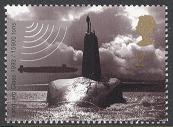|
British Royal Navy Vanguard class, SSBN
 HMS Resolution conducted the first Polaris patrol in 1968 and from then she and her sister ships- Repulse, Renown and Revenge- maintained a continuous deterrent. HMS Resolution conducted the first Polaris patrol in 1968 and from then she and her sister ships- Repulse, Renown and Revenge- maintained a continuous deterrent.
The British Government announced its intention to replace the Polaris missile system with Trident, a Submarine Launched Ballistic Missile (SLBM) system, in 1980. VSEL (Vickers Shipbuilding & Engineering Ltd) were awarded the contract to develop the design in 1982.
While the submarines that carried Polaris, the Resolution class, had been an adapted version of the earlier Valiant Class attack submarines, the new submarines were designed specifically to carry Trident. They were based largely on the American Trident submarines, the Ohio Class, with the only major difference being they would have 16 missile tubes while the Ohio Class had 24. Twice as heavy and twenty meters longer, the new Trident submarines would hold many advantages over the aging Resolution Class: with a fourth deck there was more space, while increased automation meant 17 fewer personnel. The Trident submarines would also have improved sonar and carry the Spearfish torpedo.
The lead ship, Vanguard, was ordered on April 4, 1986 from Vickers Shipbuilding & Engineering Limited (VSEL) and was laid down at Barrow-in-Furness later that year. Vanguard conducted first of class sea trials between October 1992 and 1995, undertaking the first test firing in 1994 and embarking on her first operational patrol later that year. The Resolution Class were retired from service as the Vanguard Class became operation, with the Repulse decommissioning in 1996 and bringing the age of Polaris to an end.
All four Trident submarines are based at HM Naval Base Clyde (Faslane) and are members of the 1st Submarine Squadron. Faslane has received an investment of £5 billion in order to support the Trident submarines, including the building of a finger jetty and a covered shiplift facility, which can raise a submarine out of the water.
Vanguard class has four 21 inch torpedo tubes and carries Spearfish and Tigerfish torpedoes for use against surface or submarine targets. These defensive weapons would be of great importance when the submarine is at its most vulnerable: during firing procedure when it rises from the depths to just below the surface, and after firing, when it may have revealed its position to the enemy.
With the entry of the last boat, Vengeance, into service in 1999 the Navy found itself in a position where it could comfortably maintain the deterrent patrol. This has prompted suggests that one Trident submarine could be converted to carry cruise missiles, an option the Americans are considering with their early Ohio Class Trident submarines.
Specifications, Vanguard class:
Displacement (srf/sub tons): 13,650/15,900
Dimensions (L*B*D feet): 491`8*42`0*39`4
Propulsion: Rolls-Royce Pressurized Water Reactor (PWR-2) 27,500hp, 2*GEC geared steam turbine, one screw
Speed (sub knots): 25
Range (srf/sub miles@knots): not relevant
Diving depth (feet): 900
Complement: 13 officers 121 enlisted
Missile: 16*SLBM Lockheed Trident II nuclear ballistic missiles
Torpedo: 4*21" (533 mm) bow torpedo tubes can fire Spearfish torpedoes
Armament: none
Mines: none
Construction
Order for the four boats of the class was placed - the lead ship Vanguard, with Vickers Shipbuilding & Engineering Ltd (VSEL), all launched between 1992 and 1998.
Back to History Index
 |
United Kingdom |
2001 |
Vanguard class 1992, SSBN |
|